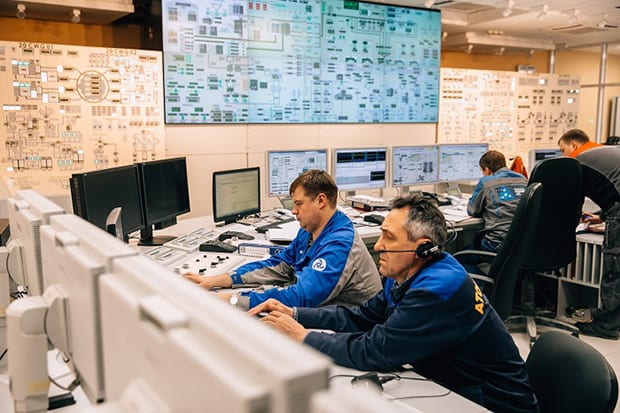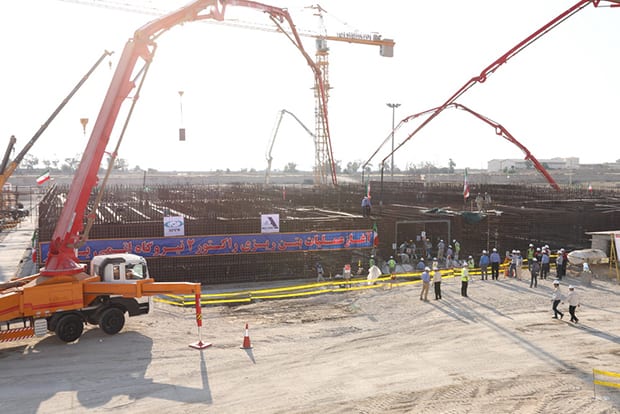One Nuclear Power Project Delayed; Three Leap Forward
Credit to Author: Aaron Larson| Date: Thu, 14 Nov 2019 13:55:18 +0000
The post One Nuclear Power Project Delayed; Three Leap Forward appeared first on POWER Magazine.
The long-overdue Olkiluoto 3 nuclear power plant (NPP) in Finland has been delayed again, but nuclear projects in Russia, Canada, and Iran achieved important milestones in November.
New Novovoronezh Unit Enters Commercial Operation
Rosatom announced on Nov. 1 that Unit 2 at the Novovoronezh Nuclear Power Plant II entered commercial operation 30 days ahead of schedule (Figure 1). The unit contains Rosatom’s flagship Generation III+ VVER-1200 reactor. It’s the third such unit placed in service, following Unit 1 at the site, which entered commercial operation in February 2017 and was a POWER Top Plant award winner that year, and Unit 1 at the Leningrad Nuclear Power Plant II, which went commercial in October 2018.
 |
| 1. Operators are shown here in the Novovoronezh nuclear power plant control room. Courtesy: Communications Department of Rosenergoatom |
“Hundreds of nuclear specialists contributed to the implementation of this project. А new powerful generation source was added to the Russian energy system. We can now use this dual-unit NPP design as a reference for our foreign projects,” Alexander Lokshin, first deputy director general for operations management of Rosatom and president of ASE Group of Companies, said in a press release. “We have accumulated vast experience in construction, production organisation, procurement, supply, and finance, as well as our continuously increasing effectiveness. This is crucial to meeting modern market requirements and facing the large-scale challenges when constructing nuclear power plants,” he added.
The launch of the reactor increases the share of nuclear power in central Russia’s electricity grid to 27%. The unit has a projected lifetime of 60 years, with the possibility of an additional 20-year extension. Rosatom said many other countries, including Bangladesh, Belarus, China, Finland, and Hungary, have chosen to incorporate VVER technology into their commercial nuclear power programs, and all are in various stages of implementation.
Fuel Load Underway at Darlington Unit 2
Ontario Power Generation (OPG) reported on Nov. 12 that the refurbishment of Darlington Unit 2 remains on budget and on schedule. The company said 90% of critical work for Unit 2 was complete, and 40 of 58 major plant systems have been declared available for service.
All 960 feeder tubes have been installed on Unit 2 (Figure 2). Feeder pipes are vital to the safe operation of the nuclear reactor, because they carry the coolant required to cool nuclear fuel.
 |
| 2. A welder on the Darlington refurbishment project welds a lower feeder to a middle feeder during the assembly of one of 960 feeder tubes on the Darlington Unit 2 reactor. Courtesy: OPG |
“Feeder tube installation is a complex process that has historically been a challenge on nuclear refurbishment projects around the world,” Dietmar Reiner, OPG’s senior vice president, Chief Project Officer, said in mid-September when the work was still in progress. “We’ve experienced challenges on the work series, but are making great strides in improving performance by applying lessons learned, tackling issues head-on and working collaboratively with our project partners.”
With the tubes now in place, the team is preparing to load fuel into the reactor core. OPG worked with BWXT Nuclear Energy Canada over a five-year span to develop a detailed plan for loading each of the 6,240 new fuel bundles into the core in the correct location and sequence. This work series involves the insertion of shield plugs, closure plugs, and fueling the core with fuel bundles.
Unit 2 is scheduled to return to service in the second quarter of 2020, after which, OPG plans to begin refurbishment of Unit 3. Plans and preparations continue to be developed for Darlington Units 1 and 4. The overall project was expected to take 10 years and remains on schedule for completion in 2026.
Concrete Pouring Begins on Bushehr Unit 2 in Iran
The Atomic Energy Organization of Iran (AEOI) held a ceremony on Nov. 10 to mark the first concrete pouring on Unit 2 of the Bushehr NPP. The concrete pouring (Figure 3) is one of the key construction milestones, marking 30% completion of the project, AEOI said.
 |
| 3. Concrete pouring officially commenced at the Bushehr Unit 2 site on Nov 10, 2019. Courtesy: AEOI |
The contract for Bushehr Units 2 and 3 was signed in November 2014 between owner Nuclear Power Production and Development Co. and Russian contractor Atomstroyexport Co., an affiliate of Rosatom. The contract includes the design and construction of two 1,057-MW units.
On-site work began on Unit 2 in September 2016. Since the start of construction, more than 3 million cubic meters of material have been excavated, according to AEOI. In addition, 3,000 tons of Iranian-built rebar has been installed in the Unit 2 reactor. AEOI said about 350,000 tons of cement is expected to be used (1,000 to 1,500 tons daily).
The site is also home to Bushehr 1—a 1,000-MW unit that entered commercial operation in September 2013. It is the only operational commercial nuclear reactor in the country.
Olkiluoto Schedule Under Review
Teollisuuden Voima Oyj (TVO)—owner of the Olkiluoto 3 (OL3) project—said the Areva-Siemens consortium that is supplying the plant will perform a schedule review and provide an “overall rebaseline schedule” for the final phases of the project in December. Construction on the unit began in August 2005. The plant was originally expected to commence commercial operation at the end of April 2009, but delays and cost overruns have plagued the project.
The most-recently revised schedule was released in July. It estimated nuclear fuel would be loaded into the reactor in January 2020, the first connection to the grid would take place in April 2020, and the start of regular electricity production would occur in July 2020. The latest estimates suggest the project is six weeks behind schedule.
“Although, the completion of the plant unit will be further delayed, we are very close to reach the fuel loading phase and start-up of the OL3 EPR unit. TVO is currently preparing fuel loading application,” Jouni Silvennoinen, TVO’s director of the OL3 EPR project, said in statement released Nov. 8.
As Silvennoinen noted, OL3 is based on EPR technology. The EPR is a third-generation pressurized water reactor, capable of producing about 1,650 MW of power output. Taishan Unit 1 in China was the first EPR to enter commercial operation in December 2018. It was recognized as a 2019 POWER Top Plant award winner this month.
—Aaron Larson is POWER’s executive editor (@AaronL_Power, @POWERmagazine).
The post One Nuclear Power Project Delayed; Three Leap Forward appeared first on POWER Magazine.